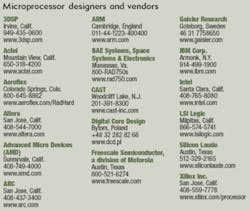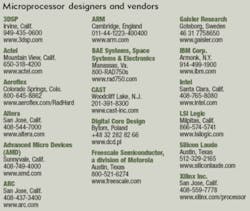By Courtney E. Howard
Military electronic systems designers can choose from a wealth of microprocessors, and the rapidly advancing pace of technology shows few signs of slowing. In fact, microprocessor and microcontroller suppliers continue to expand product portfolios with their latest innovations.
Aeroflex Colorado Springs, for example, has historically developed radiation-hardened 16-bit microcontrollers, which also integrate such added peripherals as a universal asynchronous Receiver-transmitter (UART), a 1553 bus, and general-purpose timers.
Yet the Colorado Springs, Colo.-based company has broken new ground with its release of the LEON 3-FT SPARC-based rad-hard System On a Chip (SOC). The new 32-bit LEON 3-FT SOC is designed to thwart obsolescence, by providing performance and system support sufficient to satisfy current and future requirements for small and fast satellite telemetry and control systems.
“Next-generation satellite telemetry and control applications are becoming more demanding, requiring lower power, higher performance, and advanced levels of integration with standard buses and peripherals such as SpaceWire, cPCI [compact PCI], and Ethernet,” says Dave L. Stevenson, P.E., manager of the Aeroflex Colorado Springs Systems Group.
When selecting the optimal solution for a specific system, Stevenson suggests weighing a few crucial factors. “Integration and performance are important decision factors when designing a new system,” he says. “However, third-party support for software development tends to become the crucial element for most embedded systems.”
Another industry player and a provider of field-programmable gate arrays (FPGAs), Xilinx Inc. in San Jose, Calif., offers several different options for programmable embedded processing, each tailored to fit specific design requirements and applications.
“The design requirements should dictate the performance range and feature set for a processing solution,” says Jay Gould, senior product manager of embedded solutions at Xilinx. “FPGAs are now used in almost every kind of embedded system application, so the question becomes hard vs. soft cores to optimize for performance or size and flexibility. With FPGA-based processing solutions, everything is configurable, and soft processing elements can even be added to the design well into the development cycle.
“Soft processing cores and IP allow for quickly available off-the-shelf devices that can still offer the benefits of flexibility, as well as on-board RAM and many other system capabilities,” Gould says. “The processing FPGA is now a vortex device, consolidating numerous functions and discrete parts into a single device.”
At the same time, technology companies serving the defense industry, such as those included in the list on the right, understand well the needs of military electronics applications.
“Given the often rigorous size, weight, and power (SWaP) restrictions on military electronics, Xilinx is seeing an increased uptake in its Virtex-4 FX family of FPGAs with the hardcore embedded PowerPC 405 GPP in order to reduce power consumption and footprint,” says Manuel Uhm, senior marketing manager of Xilinx Inc.’s DSP Division. “In applications such as software-defined radio that must support an RTOS, having the performance of the PowerPC 405 with a memory management unit, for example, allows for a single-chip modem solution, as opposed to two or more chips.”
The benefits of fitting more technology on a single chip are many. Professionals save not only space system wide, but also design costs and system maintenance, integration, and support time.
As processor technology requires increasingly less space, we can look forward to seeing more and more technology on the silicon. In turn, the defense market can look forward to gaining ever more functionality from smaller, faster, and cooler systems.
null




